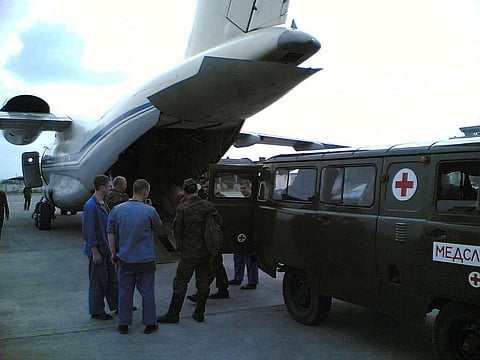

Chechnya has always been a conflict zone ever since the 18th century, and this article will not cover the actions of Imam Shamil and other figures during this era, it will simply take too long and span over several thousand words, we instead will begin our story at 1991 - the dissolution of the USSR, we will also only discuss the first Chechen war and the interwar period.
The USSR was no more, and the communists lost political power and capital across all the republics and oblasts of what was once the Union, in Chechnya it was no different - the local communist authority was overthrown by the former Soviet Air Force general Dzhokhar Dudayev, who declared the independence of his region as the Chechen Republic of Ichkeria.
The locals gave it popular support, as most Russian natives (Grozny for example was, at the beginning of the 20th century, 50% Russian, but after the Soviet reparations to the ethnic minorities post WW2, became a Chechen majority once again) who were already a minority either fled of their volition or were intimidated to leave, some were also killed, and there was no popular opposition to Dudayev at the time
And although Dudayev largely had popular support, there were still segments of society who opposed him, such as the parliamentarians and figures such as Umar Avturkhanov and Salambek Khadzhiev, however, their efforts were largely a failure, although civil war was defacto the situation in Chechnya in 1993.
War would not start for the next 3 years between 1991 and 1994, the Russian President at the time, Boris Yeltsin, had to argue, bicker, and fight with the leaders of other ethnic enclaves within the new Russian Federation, Republic of Bashkortostan was flirting with independence and had political wars fought with Moscow at the time, Tatarstan also declared independence by itself and was engaged in the same political manoeuvres as Bashkortostan, these fights would continue for three years, however, by the end of it, all 82 out of 83 republics would sign the appropiate agreements delegating autonomy, federal representation, and the likes between themselves and the Russian Federation.
Chechnya was the only country that did not sign such an agreement with Moscow.
In 1994, the war began as Russian authorities attempted to forcefully regain control of the breakaway Republic, and it was one of the first - and until 2022, one of the most deadly - wars in the Post-Soviet era within the republics
Poor planning, underestimating enemy forces, incomplete data, the severe lack of command and control elements that would regulate the actions of the Russian Armed Forces, outdated targeting banks, and simply the purposeful targeting and the Soviet doctrine of mass infantry and artillery assaults, led to anywhere from 30,000 to 100,000 civilians being killed during the war and another half a million internally displaced refugees, and Chechen infrastructure, cities, and basic aspects of livings were ruined, with mass casualities in the Russian side as well, with entire brigades and divisions becoming combat ineffective due to having suffered many killed and wounded.
It would be unwise to write about the entirety of the first Chechen war, entire books were made and they only cover "half" of what actually happened in that war, the above is simply the factual, short summary of what occurred.
There are many reasons why the struggle panned out the way it did, men like Aslan Maskhadov and Dudayev, for example, were former Soviet officers, one in the Airforce and the other in Artillery, who, by all accounts, were professionals in their line of work, with the mixing of irregulars and local warlords, the Chechen side had a reserve of professional men-at-arms and officers and irregular guerrilas.
The Khasavyurt Accord in August 1996, signed in Dagestan between the Russian representatives and Chechen representatives of Ichkeria, put an end to the war, it gave defacto independence to Chechnya with no official claim to independence, joint committees were made by the two entities to prevent looting, regain social order, and have the most basic relations between the two, and for a time, the war stopped, it ended, and it was no more, which was a blessing for the soldiers and the civilians.
But it would only last for another four years.
But things were not going well for Chechnya, a destroyed economy, local warlords (of both the criminal and religious variety) who refused to recognize the authority of the Ichkerian government, and religious fundamentalists who were exported to Chechnya and proceeded to have clashes in Chechnya with the Ichkerian authorities, both politically and on the streets, it would later span out of control when in 1999, Shamil Basayev had the wonderful, smart, and calculated plan to invade Dagestan, in which Russian authorities would consider this invasion a break of the peace accords, scrap it completely, and then proceeded to enter Chechnya once again, and this time they came prepared.
Some people think Basayev had deals with the FSB and was later betrayed by them, but the reality of the situation remains unknown.